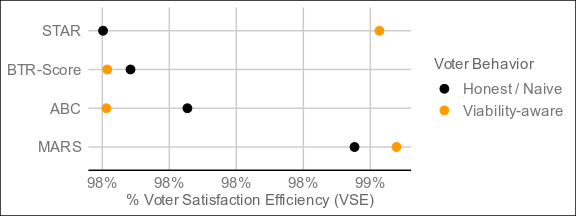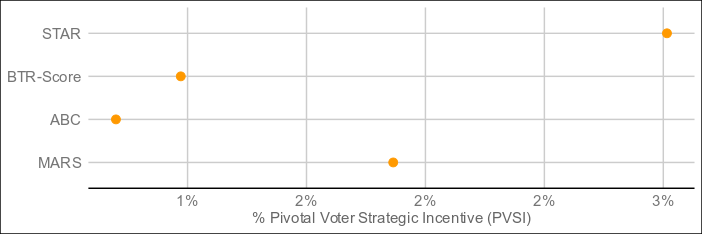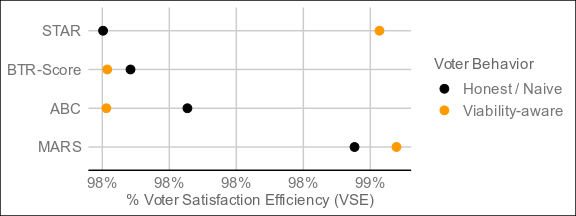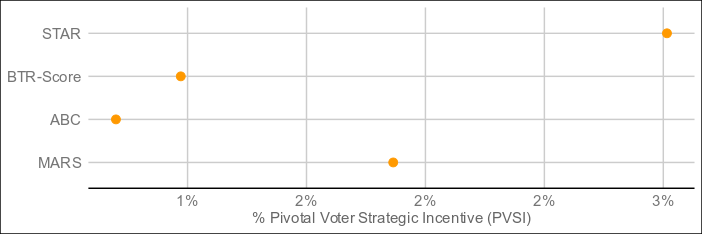BTR-Score is discussed here, while what I'm provisionally calling ABC ([A]pproval-[b]y-[c]onsensus) is a method described in the ballot below:
Rate each candidate from A to F, A being best and F being worst.
Candidates receive 1 point for each A, B, or C rating and 0 points for each D, E, or F rating.
Equal ratings are allowed. Unrated candidates are automatically rated F.
+-----------------++-----------------+
| Approve || Disapprove |
+-------------+-----+-----+-----++-----+-----+-----+
| Benjamin | A | B | C || D | E | F |
+-------------+-----+-----+-----++-----+-----+-----+
| Carol | A | B | C || D | E | F |
+-------------+-----+-----+-----++-----+-----+-----+
| Christopher | A | B | C || D | E | F |
+-------------+-----+-----+-----++-----+-----+-----+
| James | A | B | C || D | E | F |
+-------------+-----+-----+-----++-----+-----+-----+
| Jean-Luc | A | B | C || D | E | F |
+-------------+-----+-----+-----++-----+-----+-----+
| Jonathan | A | B | C || D | E | F |
+-------------+-----+-----+-----++-----+-----+-----+
| Kathryn | A | B | C || D | E | F |
+-------------+-----+-----+-----++-----+-----+-----+
| Michael | A | B | C || D | E | F |
+-------------+-----+-----+-----++-----+-----+-----+
The two lowest-scoring candidates are compared and the one rated lower by more voters is eliminated. This is repeated until the final remaining candidate wins.
The motivation for ABC is that it's a form of approval voting that also preserves preferences between both approved and disapproved options. It always elects either the Condorcet winner or the most approved member of the Smith set (or very rarely second most).
ABC is in a family of what I refer to as 'lexical' methods (as in lexical threshold), and is the sequential pairwise elimination member of the set, in the same way BTR-Score is to score. (The top-two version is the excellent SCATTR proposal, which in testing performed better than Approval Top Two but worse than STAR.)
The below are the result of 4,000 simulated elections following the exact conditions of the STAR paper:
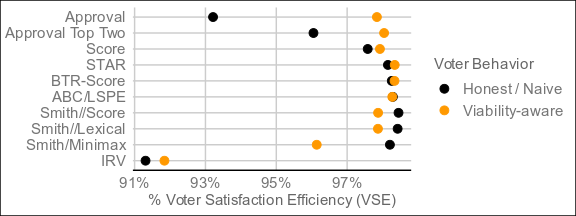
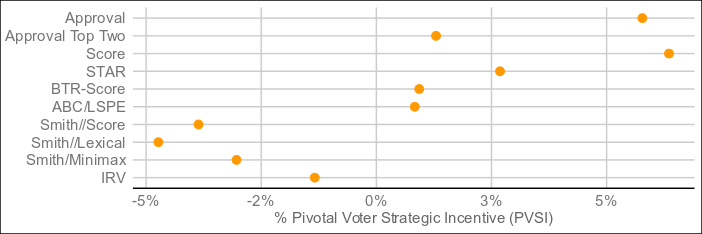

And the result of 10,000 simulated elections with 5,001 voters each:
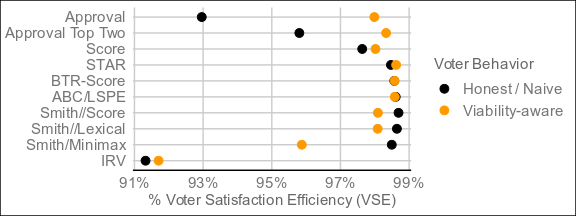
@Lime has pointed out that ABC is similar to Forest Simmons's Approval Sorted Margins, though given the latter's monotonicity and more complex heuristic it's doubtful that they're identical. Interestingly, Simmons is credited as the discoverer of sequential pairwise elimination methods.
I believe ABC may also pass the chicken dilemma as Approval Sorted Margins does, according to my understanding of the criterion.
If I understand correctly, in a situation in which candidates X & Y are similar and X+Y>50%>Z>X>Y, Y voters should not be able to force a win for Y by refusing to vote X over any other candidate while X voters honestly vote Y over Z. The problem is that if you don't know whether your candidate is X or Y, the strategic score vote is to score the other candidate zero.
However, if it were possible to score the other candidate zero while still ranking them above Z, there's no incentive for either faction not to do at least that.
Under ABC, the strategic choice for both factions is to rate the other candidate at worst E, provided that they both rate Z last, as doing so will not risk raising their opponent's score above their own candidate's while still ensuring that their combined preferences beat Z.
If Y voters defect by not rating X above Z, they cannot force a win for Y, as X would beat Y pairwise and then go on to lose against Z. If Y happened to be more preferred than X, the same would go for X voters. If neither faction defects then either candidate defeats Z. Thus this method passes the chicken dilemma as far as I can tell, but I welcome any corrections. (I may be overlooking any potential for turkey-raising, for one.)
Where ABC may have a slight edge over BTR-Score is the fact that ABC removes the incentive to not rate disapproved candidates over even more disapproved candidates (because rating any candidate necessarily means partial support in score), which may be why ABC appears to be more resistant to Burial. I believe this method is worthy of serious consideration.
Both BTR-Score and ABC are probably the best found yet in terms of accuracy and strategyproofness as related to simplicity, and the results above seem to bear that out. I'd definitely appreciate any independent testing in vse-sim or other simulations with different voter models so I know it's not just a quirk of how I wrote the method (though even that may be useful insight).
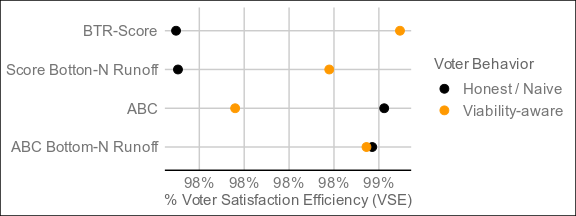
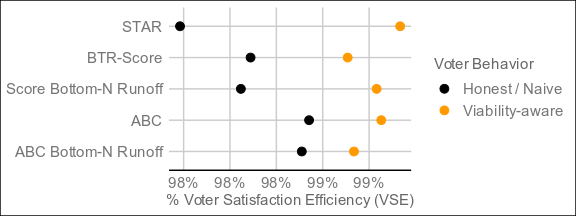
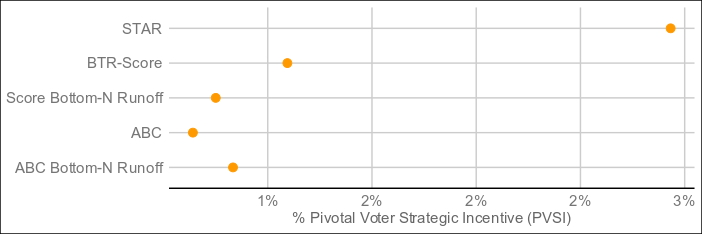

 Have I got great news for you... The title of this thread is officially obsolete.
Have I got great news for you... The title of this thread is officially obsolete.